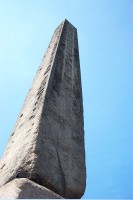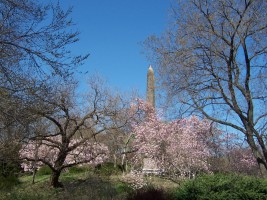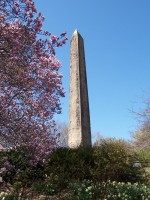Cleopatra's Needle
Just west of East Drive around 82nd street, southeast of the Great Lawn and to the west of the Metropolitan Museum of Art
Cleopatra's Needle actually has nothing to do with Cleopatra. It is one of a pair of obelisks raised before the Temple of the Sun in Heliopolis around 1440 B.C. to mark the third jubilee of Pharoah Tutmosis III. It was snatched from Egypt against the wishes of Egyptian and European governments and brought to America by William H. Vanderbilt It arrived via steamship on Staten Island in July of 1880 and was towed on pontoons to the foot of 96th street, where the 69-foot shaft was placed lengthwise on a cradle made of two parallel beams joined by struts, attached to a pile-driver engine with a winch. The cradle, set on rollers, rested on tracks made of wooden beams. An anchor chain borrowed from the Dessoug connected a drum in the engine to a block anchored in the street ahead; the engine pulled itself and the monolith forward by winding the chain around the drum. Extra beams were used to extend the track forward, length by length, as work gangs cleared the way and periodically moved the block forward.
As autumn turned to winter and the city watched, enthralled, the needle was inched forward, day and night. Setting out on September 30, the obelisk climbed 96th street and reached the West Boulevard (Broadway) on October 27. It was laboriously turned south, then rolled down to 86th street and turned east, entering the park on November 25. On December 16, the obelisk reached Fifth Avenue (on the East side of central park) where it was turned south. It re-entered the park at 82nd street and reached its destination in the Graywacke Knoll on January 5, 1881 - 112 days after it touched ground in Manhattan. (New York Times, Sunday September 14, 1997)



